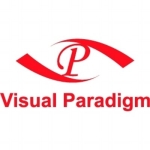What is our primary use case?
I usually use Visio for really high-level conceptual modeling. Ironically, this works well with iServer. But, I use Visio for conceptual modeling since it makes it easy to draw things and is not as strict. This is because, at the conceptual level, one is not properly familiar with the details or constraints. This way, a business person would be able to critique something as being incorrect or not linked or drawn properly.
What is most valuable?
Visio makes it easier than with other tools to do such tasks as changing things or coming up with one's own visual style for presentation purposes. Mostly, the solution is employed for presentations made to business people, with the aim of facilitating their understanding of the design one wishes to use. Due to its greater flexibility when it comes to how things are joined together with lines, it is possible to put things together that would not work in a physical environment. This reduced constraint is good, as it allows one to initially familiarize himself with his system and ask the appropriate questions for which he may not have answers at the moment. At the minimum, this allows a person to put something up for critique in the event that it is incorrect.
The automated tools exist for making the computer do the dumb stuff. It may be worth going out to the market to see the sort of things people are trying to obtain. The solution integrates well with other tools and one can bring Visio diagrams into Word. Once in Word, a person can open the diagram for editing purposes if need be and then close it again and keep it in Word. So, all the integration capabilities with the other Office products is great. I can't think of much that I wish to add to the solution.
What needs improvement?
When creating a database, more stringency is required, as the computer is really dumb. A person is a lot more constrained, much more so when using the actual database creation tool, such as erwin Data Modeler. So the solution's flexibility can be perceived as both a strength and a weakness.
Visio is a general modeling tool, which encourages so many things beyond the use of mere data models. I think it's pretty good. Years back, when we first saw Visio being used with social security, the solution promoted itself as the missing piece. Word, Excel and Outlook were available. There was actually a piece missing where they stuck on the Windows logo.
In the late '90s or early 2000s it was possible to buy Visio with and without Office. They then removed this capability. Nowadays, one can obtain 365 but, with Visio, the component must be bought separately. The issue exists more with the purchasing and it would be nice to have it included as a standard feature. I believe they've now checked in Power BI as a standard component with Office, but Visio has so many more uses, since business people can use it to do swimlanes. Regular people and not just those with a technical background can use it for so much more. It should just be part of the enterprise or the professional version of Office. That's what I'd say. It's just so damn useful.
One of the things that was removed prior to it getting spun out was an enterprise version of Visio which could be set up, kicked off and actually go through one's network to ping everything that was attached to it, including printers, routers, PCs, laptops, et cetera. It would then bring all that information back and write a network diagram itself of all of those things. I thought that was a pretty cool part of the product. I'm not sure whether people now have network tools that do the same thing and that's why it's not used anymore. But, it was nice to see this sort of automation.
For how long have I used the solution?
I have been using Visio since it came out in 1995 or 1996.
Buyer's Guide
Visio
September 2025
Learn what your peers think about Visio. Get advice and tips from experienced pros sharing their opinions. Updated: September 2025.
869,832 professionals have used our research since 2012.
What do I think about the stability of the solution?
The solution seems to be pretty stable, because I've opened models that I wrote 20 years ago and it still reads them without incurring frequent crashes. I did something flaky the other day which it didn't like. I don't know whether that was because it was going through a virtual machine and have yet to track down what the core issue was. However, overall, things have been pretty stable.
What do I think about the scalability of the solution?
When it comes to scalability, I suppose that Visio is like any other product. One of the drawbacks of any Office product is its design for a single person. There exist ones on the web which allow for online editing in Excel, but many of the features I use do not exist in this version. This is a pain point.
We are talking about a one-person product, but the fact that you can print it off as a PDF and share it with others is a good feature of it. Visio differs from a real modeling tool, an expensive one such as, say... erwin Data Modeler, in that the latter has its own repository for storing models, which another person can access and use for modifying the relevant model. The model can be split into an overall one and a subject area. This way, two people can work in different subject areas. As long as two people are not working on the exact same object they will avoid stepping on each other's toes. Visio is akin to any other Office products, in that it involves a single person at a time per document.
How are customer service and support?
I don't believe I have ever had to contact technical support to get the solution to work. We usually look up things on the internet. For most Microsoft products the help is not too bad. The last time I had to contact Microsoft support was years ago, concerning flowcharts, I believe.
For any issues involving the local installation I would contact our own infrastructure team. This said, I don't believe I have ever had to go out with an actual bug in the product.
How was the initial setup?
I am not involved with the infrastructure side, but my understanding is that the initial setup was relatively straightforward. I had to put in a purchase order when I started this new role, but obtained access to the tool pretty quickly. I'm assuming that it is similar to other Microsoft products, in that there is a standard implementation, with the IT people having a fixed method of configuration, as with other Office products, which are rolled out.
When it comes to the setup, I have a couple of what are referred to as stencils, which are the things on the side that can be used for creating one's own series of diagrams or its components. I have a couple of these which I reuse. This is the only thing worth mentioning were one setting it up from scratch. But, many of the standard objects are pretty good and extensive. As such, the setup is not too difficult. Neither is it difficult to create one's own look and feel. So, it's pretty good.
What's my experience with pricing, setup cost, and licensing?
I believe Visio to be priced pretty reasonably. Erwin Data Modeler may be a bit on the pricey side nowadays. When it was spun off from Computer Associates, they did so as a separate product and someone else bought it. I seem to recall at the time that the price either doubled or trebled, although I don't remember the reason for this. It was not clear to me what extra value was being offered for the price. Likely, the sole problem with erwin Data Modeler is that the price point is a tad on the high side. It can make selling to clients challenging and they are generally put off by the price.
Probably, it would have been better if erwin Data Modeler was the introduction to the environment whose creation is being attempted, meaning the DI suite and all the other parts involved in the governance, their glossary and all the bits and pieces. As the first taste is always free, it might've been better to have erwin Data Modeler at a lower price point. Once a person has obtained this product he would likely feel compelled to buy the other tools that work with it, rather than attempting to obtain something which does not. This would allow one to lower his price for the initial tool and then charge a bit more for those that nobody else has in their possession, such as one's involving data governance. This said, I'm not really involved in sales or marketing, so what I say should be taken with a grain of salt.
Which other solutions did I evaluate?
Visio is really good for high-level presentations but, when it comes to much more lower-level tasks, the best I've found so far is erwin Data Modeler and the DI, the governance suite that they've put out more recently. I've also worked with Oracle Data Modeler. One can't argue with the price on that one since it is free and presents no issues if money is lacking for other expenditures. If a person can do the drawings and present something to people then he can actually generate databases out of it, which is what one's end game is supposed to be anyway. It's not as pretty and it's a little bit more fiddly to do when things start to get complicated.
What other advice do I have?
When I first started, everything was on-premises, although I do not recall if it switched to Azure at a later point. I believe I used it in 365. I am pretty sure the later ones are part of Office 365 or appear as add-ons, as they are not included.
My advice is that a person first work out what he wishes to use the tool for, to see if it suits his needs. While it's great for presenting information to people, it is not as good in the end when it comes to actually trying to build a product out of it. Of primary importance is that the person come up with his own look and feel for the organization, with a focus on business oriented issues rather than those of a technical nature. This would entail coming up with one's own color scheme or design and then remaining consistent in this domain. It is helpful to present to business people in a format with which they are familiar.
As the product will pretty much do what one wishes, which is nice, the focus should remain more on the presenting side rather than on its use. Certain products pose a challenge when it comes to getting them to comply with one's wishes, but Visio is a bit easier in this regard.
As a presentation tool and a high-level design tool, I rate Visio at least a nine out of ten.
Disclosure: My company has a business relationship with this vendor other than being a customer. Partner

















